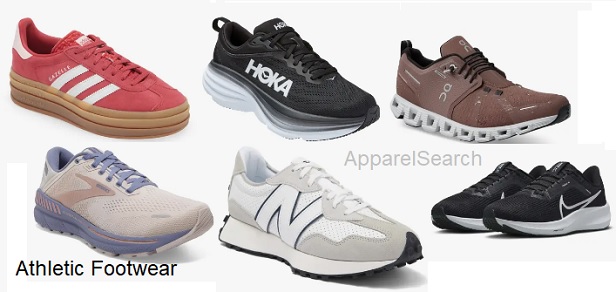Athletic Shoes: The Evolution of Performance Footwear
Meaning and Styles:
Athletic shoes, also known as sports shoes or sneakers, are a specialized category of footwear designed primarily for sports, physical exercise, and various athletic activities. They encompass a diverse range of styles, including running shoes, basketball shoes, soccer cleats, cross-training shoes, hiking boots, tennis shoes, and more. Each style is crafted to cater to the specific demands, movements, and requirements of the respective sport or activity.
Functionality:
The functionality of athletic shoes is paramount. They offer features such as shock absorption to reduce impact on joints, arch support for proper alignment, breathable materials to control moisture, durable outsoles with enhanced traction for grip, and specialized cushioning technologies to optimize comfort and energy return. The design and structure of athletic shoes aim to enhance performance, prevent injuries, and provide stability, allowing athletes to perform at their peak while minimizing physical strain.
History and Evolution:
Early Years: Athletic shoes date back to ancient civilizations where early humans used simple footwear made of plant fibers or animal hides for physical activities. However, these lacked the technical advancements of modern athletic shoes.
19th Century: The mid-19th century saw the emergence of rubber-soled shoes, setting the stage for more comfortable and versatile athletic footwear.
20th Century: The 20th century witnessed significant advancements. The introduction of iconic brands like Converse in the early 1900s marked the beginning of sports shoes' popularity. The 1920s brought the Converse Chuck Taylor All Star, revolutionizing basketball footwear.
Post World War II: After World War II, companies like adidas (1949) and Puma (1948) were founded, further contributing to the evolution of athletic footwear. adidas introduced the first screw-in studs in soccer cleats.
1970s-1980s: The 1970s and 1980s saw the rise of jogging and fitness trends, spurring innovation in running shoe technology. Nike's Waffle Trainer (1974) and Air technology (1979) revolutionized the running shoe landscape.
1990s-2000s: The 1990s and early 2000s saw advancements in lightweight materials, advanced cushioning systems (e.g., Nike Shox), and the introduction of cross-training shoes, catering to diverse sports and training regimens.
Present Day: Today, athletic shoes continue to evolve with advancements in sustainable materials, smart technology integration (e.g., smart trackers), and customizable features. Brands like Nike, adidas, Under Armour, Reebok, and Puma remain at the forefront of innovation.
The history and evolution of athletic shoes demonstrate a relentless pursuit of performance enhancement, comfort, and style. From simple beginnings to high-tech, purpose-built designs, athletic shoes have become an integral part of both sports and everyday fashion, impacting not only athletes but a wide range of individuals seeking comfort and functionality in their footwear.
Technological Advancements in Athletic Footwear Design and Production:
Technology has profoundly impacted the design and production of athletic footwear, leading to superior performance, enhanced comfort, and overall excellence. Some key advancements include:
Advanced Materials:
Lightweight, durable, and breathable materials like engineered mesh, knits, and high-performance synthetic fabrics are utilized to improve comfort and reduce weight without compromising support.
Cushioning Technologies:
Innovative cushioning systems such as Nike Air, adidas Boost, and Under Armour HOVR provide exceptional shock absorption and energy return, enhancing comfort and reducing the impact on joints.
3D Printing:
3D printing enables precise midsole structures, allowing customization based on an individual's foot shape, arch type, and running style for optimal support and cushioning.
Data Analysis and Biomechanics:
Sophisticated technologies analyze biomechanics and gait patterns to tailor shoe designs, enhancing performance and minimizing the risk of injuries.
Customization:
Brands offer customization options, allowing customers to personalize colors, designs, and even fit for a more tailored experience.
Sustainable Manufacturing:
Environmentally friendly practices and sustainable materials are increasingly used in production to reduce the environmental impact of athletic footwear.
Smart Technology Integration:
Smart sensors and electronics are incorporated to monitor and provide real-time feedback on performance, offering insights to improve training and prevent injuries.
Popular Athletic Footwear Brands:
Some of the most popular athletic footwear brands globally include:
Nike:
- Renowned for innovation and iconic designs, Nike offers a wide range of athletic footwear. Notable lines include Air Jordan for basketball, Air Max for running, and Air Force 1 for lifestyle.
Adidas:
- Known for combining style and performance, Adidas offers a diverse range of footwear. Popular lines include the UltraBoost for running, Superstar for lifestyle, and Predator for soccer.
Under Armour:
- Under Armour is recognized for its commitment to performance. The UA HOVR series for running and Project Rock for training are particularly popular.
Puma:
- Puma emphasizes style and functionality. The Puma Future Z for soccer, Clyde Court for basketball, and RS-X for lifestyle are widely recognized.
New Balance:
- Known for quality and comfort, New Balance offers popular lines like the Fresh Foam for running and the 990 series for lifestyle.
Athletic Footwear in Popular Sports and Styles:
Running:
Styles: Running shoes are designed for different distances and terrains. Popular styles include neutral running shoes, stability shoes, and lightweight racing shoes.
Basketball:
Styles: Basketball shoes prioritize ankle support, traction, and cushioning. Popular styles include high-top designs like the Nike LeBron series and the Adidas Harden Vol. series.
Soccer:
Styles: Soccer cleats are specialized for grip and agility. Styles include firm ground (FG), indoor (IC), and turf (TF) shoes. Notable lines are the Adidas Predator, Nike Mercurial, and Puma Future Z.
Cross Training:
Styles: Cross-training shoes offer versatility and stability. Notable styles include the Nike Metcon series, Reebok Nano series, and Under Armour Tribase Reign.
Tennis:
Styles: Tennis shoes emphasize lateral support and durability. Brands like Nike (Court Zoom Vapor), Adidas (Adizero Ubersonic), and Asics (Gel-Resolution) offer popular options.
Technological advancements continue to shape athletic footwear, ensuring athletes receive the best possible equipment to enhance their performance, prevent injuries, and boost comfort. The synergy of science, design, and innovation allows for a wide array of athletic footwear tailored to the unique demands of various sports.
Learn about training shoes and performance shoes.
|
|
